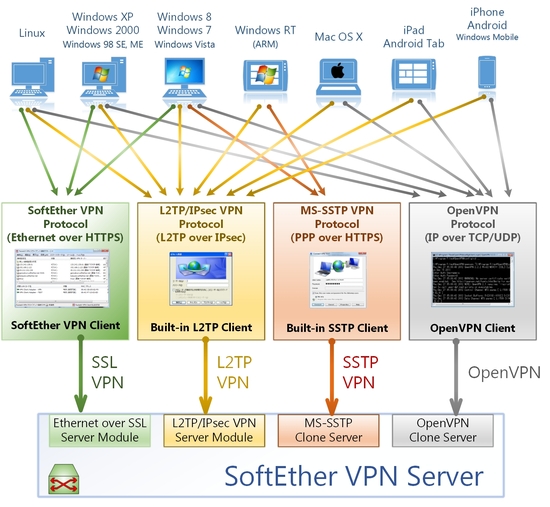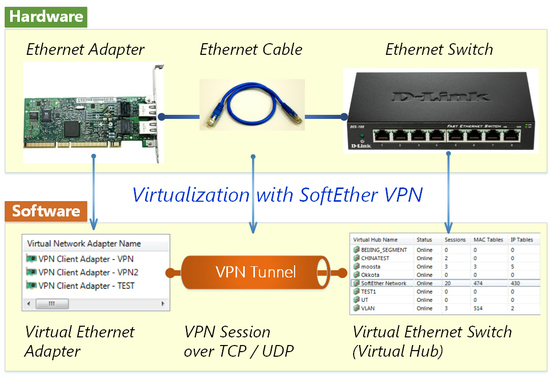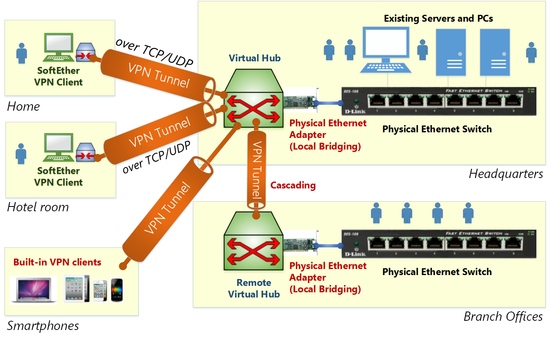Table of contents
Combined revision comparison
...
What is SoftEther VPN ?
...
 Free and open-source software.
Free and open-source software.- Easy to establish both remote-access and site-to-site VPN.
- SSL-VPN Tunneling on HTTPS to pass through NATs and firewalls.
- Revolutionary VPN over ICMP and VPN over DNS features.
- Resistance to highly-restricted firewall.
- Ethernet-bridging (L2) and IP-routing (L3) over VPN.
- Embedded dynamic-DNS and NAT-traversal so that no static nor fixed IP address is required.
- AES 256-bit and RSA 4096-bit encryptions.
- Sufficient security features such as logging and firewall inner VPN tunnel.
- 1Gbps-class high-speed throughput performance with low memory and CPU usage.
- Windows, Linux, Mac, Android, iPhone, iPad and Windows Phone are supported.
- SSL-VPN (HTTPS) and 6 major VPN protocols (OpenVPN, IPsec, L2TP, MS-SSTP, L2TPv3 and EtherIP) are all supported as VPN tunneling underlay protocols.
- The OpenVPN clone function supports legacy OpenVPN clients.
- IPv4 / IPv6 dual-stack.
- The VPN server runs on Windows, Linux, FreeBSD, Solaris and Mac OS X.
- Configure All settings on GUI.
- Multi-languages (English, Japanese and Simplified-Chinese).
- No memory leaks. High quality stable codes, intended for long-term runs. We always verify that there are no memory or resource leaks before releasing the build.
- RADIUS / NT Domain user authentication function
- RSA certificate authentication function
- Deep-inspect packet logging function
- Source IP address control list function
- syslog transfer function
- More details at Specification.
Architecture of SoftEther VPN
Virtualization of Ethernet devices is the key of the SoftEther VPN architecture. SoftEther VPN virtualizes Ethernet devices in order to realize a flexible virtual private network for both remote-access VPN and site-to-site VPN. SoftEther VPN implements the Virtual Network Adapter program as a software-emulated traditional Ethernet network adapter. SoftEther VPN implements the Virtual Ethernet Switch program (called Virtual Hub) as a software-emulated traditional Ethernet switch. SoftEther VPN implements VPN Session as a software-emulated Ethernet cable between the network adapter and the switch.
You can create one or many Virtual Hub with SoftEther VPN on your server computer. This server computer will become a VPN server, which accepts VPN connection requests from VPN client computers.
You can create one or many Virtual Network Adapter with SoftEther VPN on your client computer. This client computer will become a VPN client, which establishes a VPN connections to the Virtual Hub on the VPN server.
You can establish VPN sessions, as called 'VPN tunnels', between VPN clients and VPN servers. A VPN session is the virtualized network cable. A VPN session is realized over a TCP/IP connection. The signals through the VPN session is encrypted by SSL. Therefore, you can safely establish a VPN session beyond the Internet. A VPN session is established by SoftEther VPN's "VPN over HTTPS" technology. It means that SoftEther VPN can create a VPN connection beyond any kinds of firewalls and NATs.
The Virtual Hub exchanges all Ethernet packets from each connected VPN session to other connected sessions. The behavior is same to traditional Ethernet switches. The Virtual Hub has a FDB (forwarding database) to optimize the transmission of Ethernet frames.
You can define a local bridge between the Virtual Hub and the existing physical Ethernet segment by using the Local Bridge function. The Local Bridge exchanges packets between the physical Ethernet adapter and the Virtual Hub. You can realize a remote-access VPN from home or mobile to the company network by using the Local Bridge function.
You can define a cascading connection between two or more remote Virtual Hubs. With cascading, you can integrate two or more remote Ethernet segments to a single Ethernet segment. For example, after you establish cascading connections between the site A, B and C, then any computers in the site A will be able to communicate with the computers in the site B and the site C. This is a site-to-site VPN.
SoftEther VPN can also establish a VPN session over UDP. The UDP-mode of SoftEther VPN supports NAT traversal. The NAT traversal function allows the VPN server behind existing NATs or firewalls to accept incoming VPN sessions. You need no network administrator's special permission before setting up a VPN server on the company network behind firewalls or NATs. Additionally, SoftEther VPN Server may be placed on the dynamic IP address environment since SoftEther VPN has built-in Dynamic DNS (DDNS) function.
SoftEther VPN Server supports additional VPN protocols, including L2TP/IPsec, OpenVPN, Microsoft SSTP, L2TPv3 and EtherIP. These realizes the interoperability with built-in L2TP/IPsec VPN clients on iPhone, iPad, Android, Windows and Mac OS X, and also with Cisco's VPN routers and other vendors VPN products.
...
Version from 18:15, 20 Mar 2014
...
What is SoftEther VPN ?
...
Version as of 19:50, 29 Mar 2014
...
 Free and open-source software.
Free and open-source software.- Easy to establish both remote-access and site-to-site VPN.
- SSL-VPN Tunneling on HTTPS to pass through NATs and firewalls.
- Revolutionary VPN over ICMP and VPN over DNS features.
- Resistance to highly-restricted firewall.
- Ethernet-bridging (L2) and IP-routing (L3) over VPN.
- Embedded dynamic-DNS and NAT-traversal so that no static nor fixed IP address is required.
- AES 256-bit and RSA 4096-bit encryptions.
- Sufficient security features such as logging and firewall inner VPN tunnel.
- 1Gbps-class high-speed throughput performance with low memory and CPU usage.
- Windows, Linux, Mac, Android, iPhone, iPad and Windows Phone are supported.
- SSL-VPN (HTTPS) and 6 major VPN protocols (OpenVPN, IPsec, L2TP, MS-SSTP, L2TPv3 and EtherIP) are all supported as VPN tunneling underlay protocols.
- The OpenVPN clone function supports legacy OpenVPN clients.
- IPv4 / IPv6 dual-stack.
- The VPN server runs on Windows, Linux, FreeBSD, Solaris and Mac OS X.
- Configure All settings on GUI.
- Multi-languages (English, Japanese and Simplified-Chinese).
- No memory leaks. High quality stable codes, intended for long-term runs. We always verify that there are no memory or resource leaks before releasing the build.
- RADIUS / NT Domain user authentication function
- RSA certificate authentication function
- Deep-inspect packet logging function
- Source IP address control list function
- syslog transfer function
- More details at Specification.
Architecture of SoftEther VPN
Virtualization of Ethernet devices is the key of the SoftEther VPN architecture. SoftEther VPN virtualizes Ethernet devices in order to realize a flexible virtual private network for both remote-access VPN and site-to-site VPN. SoftEther VPN implements the Virtual Network Adapter program as a software-emulated traditional Ethernet network adapter. SoftEther VPN implements the Virtual Ethernet Switch program (called Virtual Hub) as a software-emulated traditional Ethernet switch. SoftEther VPN implements VPN Session as a software-emulated Ethernet cable between the network adapter and the switch.
You can create one or many Virtual Hub with SoftEther VPN on your server computer. This server computer will become a VPN server, which accepts VPN connection requests from VPN client computers.
You can create one or many Virtual Network Adapter with SoftEther VPN on your client computer. This client computer will become a VPN client, which establishes a VPN connections to the Virtual Hub on the VPN server.
You can establish VPN sessions, as called 'VPN tunnels', between VPN clients and VPN servers. A VPN session is the virtualized network cable. A VPN session is realized over a TCP/IP connection. The signals through the VPN session is encrypted by SSL. Therefore, you can safely establish a VPN session beyond the Internet. A VPN session is established by SoftEther VPN's "VPN over HTTPS" technology. It means that SoftEther VPN can create a VPN connection beyond any kinds of firewalls and NATs.
The Virtual Hub exchanges all Ethernet packets from each connected VPN session to other connected sessions. The behavior is same to traditional Ethernet switches. The Virtual Hub has a FDB (forwarding database) to optimize the transmission of Ethernet frames.
You can define a local bridge between the Virtual Hub and the existing physical Ethernet segment by using the Local Bridge function. The Local Bridge exchanges packets between the physical Ethernet adapter and the Virtual Hub. You can realize a remote-access VPN from home or mobile to the company network by using the Local Bridge function.
You can define a cascading connection between two or more remote Virtual Hubs. With cascading, you can integrate two or more remote Ethernet segments to a single Ethernet segment. For example, after you establish cascading connections between the site A, B and C, then any computers in the site A will be able to communicate with the computers in the site B and the site C. This is a site-to-site VPN.
SoftEther VPN can also establish a VPN session over UDP. The UDP-mode of SoftEther VPN supports NAT traversal. The NAT traversal function allows the VPN server behind existing NATs or firewalls to accept incoming VPN sessions. You need no network administrator's special permission before setting up a VPN server on the company network behind firewalls or NATs. Additionally, SoftEther VPN Server may be placed on the dynamic IP address environment since SoftEther VPN has built-in Dynamic DNS (DDNS) function.
SoftEther VPN Server supports additional VPN protocols, including L2TP/IPsec, OpenVPN, Microsoft SSTP, L2TPv3 and EtherIP. These realizes the interoperability with built-in L2TP/IPsec VPN clients on iPhone, iPad, Android, Windows and Mac OS X, and also with Cisco's VPN routers and other vendors VPN products.
...


